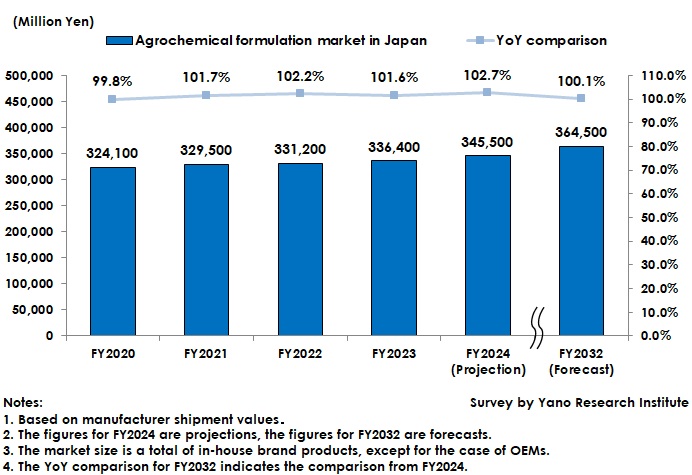No.3811
Agrochemical Formulation Market in Japan: Key Research Findings 2025
Domestic Agrochemical Formulation Market Reached \336,400 Million in FY2023, a 1.6% Year-on-Year Increase, and Projected to Attain \345,500 Million in FY2024, a 2.7% Year-on-Year Increase
Yano Research Institute (the President, Takashi Mizukoshi) surveyed the domestic agrochemical market and found out the trends of agrochemical formulations by application (farmland, non-farmland, home gardening), by type (pesticides, bactericide, insecticides, fungicides, herbicides, microbial pesticide and biotic pesticide,) the trends of market players, and the future perspectives.

Market Overview
The domestic agrochemical formulation market generated 336,400 million yen in FY2023, 101.6% of the size of the previous fiscal year, based on the manufacturer shipment value. The market has grown, despite being affected by decreasing crop acreage of paddy rice and inclemency of the weather.
While sales volume decreased due to stagnant distributor inventory, higher prices for formulations increased the market size. The domestic agrichemicals market showed a slight increase, driven by strong sales of fungicides for field crops and herbicides for both paddy rice and field crops.
Noteworthy Topics
Increase in Agrichemicals for Direct Seeding of Rice Cultivation
Direct seeding is a method of planting rice seeds directly into the arable land instead of transplanting seedlings, which is the conventional method. Direct seeding is expected to be a promising method because it eliminates the labor-intensive springtime process of raising seedlings from seeds often in a plastic greenhouse and transplanting them to arable land. Direct seeding is expected to increase the scale of paddy rice cultivation while reducing costs and labor.
There are two types of direct seeding for paddy rice: direct sowing on a dry field (sowing seeds on a dry field before submerging it), and direct sowing in a flooded field. According to the Ministry of Agriculture, Forestry and Fisheries' “Status of Latest Direct Sowing Culture and Introduction to New Techniques for Rice Produced in 2022,” direct seeding in dry fields has increased since around 2014. In 2022, the area dedicated to dry seeding paddy rice increased to 36,681 hectares, which is 3.7% larger than the previous year and 2.8 times larger than it was 20 years ago.
Agrochemical companies are strengthening their focus on developing products for dry-seeded paddy rice. They have developed various products to increase the efficiency of applying agrochemicals and to effectively control pests. These products include treatment agents for paddy rice that can be used in dry or flooded fields; seeds coated with fungicide or pesticide components; and fungicides and herbicides that can be sprayed simultaneously with seeding.
Since direct sowing of paddy rice allows labor reduction as well as increase in the scale of rice cultivation, the area dedicated to direct sowing of paddy rice is expanding. Therefore, the development of new agrochemicals for this method is expected to continue.
Future Outlook
Over the past few years, the deregulation of the agricultural policy has altered the domestic agricultural structure. As evidenced by the mid- to long-term changes in crop acreage, the agrochemical market is dipping the bottom. Due to the skyrocketing formulation material and transportation costs, the domestic agrochemical formulation market is forecast to reach 345,500 million yen, a 2.7% year-on-year increase based on manufacturer shipment values.
Challenges in the agrochemical market are expected to persist due to the declining crop acreage and the tendency to reduce the use of agrochemicals in domestic agriculture. Therefore, the markets for both agrochemical APIs and formulations are likely to level off. The agrochemical formulation market is projected to reach 364,500 million yen by FY2032.
Research Outline
2.Research Object: Market players of agrochemical formulations (agrochemical manufacturers, pharmaceutical formulators, and trading companies), organizations and government offices related to agrochemical formulations, etc.
3.Research Methogology: Face-to-face interviews by expert researchers, surveys via telephone & email, questionnaire, and literature research
Agrochemical Formulation Market
The agrochemical formulation market in this research refers to the market for pesticides, bactericides, insect-fungicides, herbicides, microbial pesticides, and biotic pesticides. The domestic market size was calculated based on manufacturer shipment values, totaling only in-house brand products, except for the case of OEMs.
<Products and Services in the Market>
Agrochemical API and agrochemical formulations, including pesticides, bactericides, herbicides, microbial pesticides, and biotic pesticides.
Published Report
Contact Us
The copyright and all other rights pertaining to this report belong to Yano Research Institute.
Please contact our PR team when quoting the report contents for the purpose other than media coverage.
Depending on the purpose of using our report, we may ask you to present your sentences for confirmation beforehand.